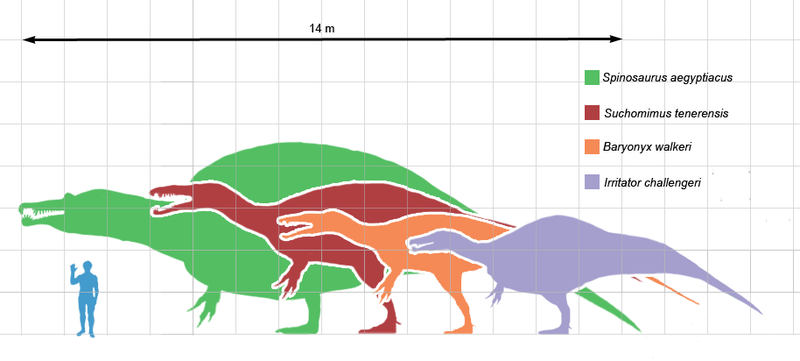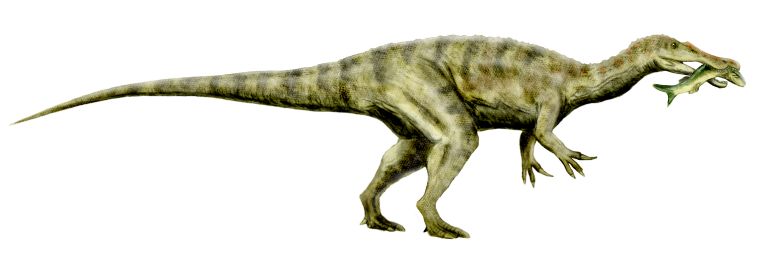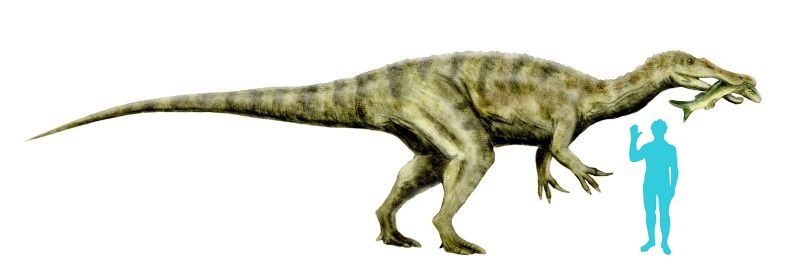The weeks pass by quickly don't they? Wow! We're already
passed the middle of the year and soon, Christmas songs will be ringing in our
heads. So before time slips away, let's get to updates, and then to this week's non-fiction article.
First of all, I have big news from my stop-motion series Planet
of the Dinosaurs that I have been working on for the past several weeks:
THE SECOND EPISODE IS FINISHED!!! That's right! I have successfully finished
the second episode, The Tropical Poles. So today, I have posted the
episode for your viewing enjoyment. You can either, watch the episode first and
then read the article, or you can read the article and then watch the episode.
Of course, you can also watch it later too. But what ever you decide to do I
really hope you like it as much as I did making it. So get ready to travel back
in time – 4,900 years into the past – to learn all about the amazing dinosaurs
that lived in The Tropical Poles:
 |
| A size comparison of different members of the spinosaurid group. |
Over the past few weeks, we've been learning about the largest carnivorous dinosaur ever to walk the earth: Spinosaurus egyptiacus. And it was a very awesome predator: it had a crocodilian-like jaw, eight-foot arms and nine-inch claws and perhaps its most obvious feature, a seven-foot tall sail on its back. But did you know that Spinosaurus wasn't the only spinosaur in the family. The spinosaur family is home to a host of remarkable dinosaurs, dinosaurs that tried really hard to be crocodiles! Today, we'll wrap up this series on spinosaurs by looking at the different species that are in this family:
 |
| Spinosaurus aegyptiacus is the largest carnivore ever to walk the earth. |
Spinosaurus: (Since we've already been looking at this monster in great depth over the past several weeks, I'll just run through the basics) Spinosaurus was the largest carnivore ever to walk the earth. At 60 feet from nose to tail and weighing 10 tons, it was a force to be reckoned with. It had sharp nine-inch claws and sharp teeth. The most obvious feature on this dinosaur is the seven-foot tall sail on its back. Scientists are unsure of its use, but it was probably used for display, temperature regulation, fishing apparatus (fish would be attracted to the dark shadow the sail cast on the water), or all three. Despite its large size and awesome strength, Spinosaurus mainly ate fish, such as the 20-foot Onchopristis. Every other animal living in Norther Africa wanted to steer clear of Spinosaurus.
 |
| Baryonyx, like its larger cousin, Spinosaurus, mainly ate fish. |
 |
| Humans are a bit puny compared to Baryonyx! |
Baryonyx: This dinosaur is known from almost complete skeletons and is closely related to Spinosaurus; but at 30 feet long, it was about half the size of its larger cousin. Like Spinosaurus, we know Baryonyx mainly ate fish because fish scales were found in a specimen's stomach cavity. Many scientists believe Baryonyx hunted like a grizzly bear, waiting at the riverbank for fish to come close enough before it would sweep the fish from the water with its powerful claws. But this dinosaur might have eaten more than just fish: bones from an ornithopod called Iguanodon have also been discovered within the stomach of Baryonyx, so perhaps other spinosaurs also ate a variety of things besides fish.
 |
| Suchomimus is often described as the dinosaur that was "trying hard to be a crocodile". |
Suchomimus: Meaning “crocodile mimic”, Suchomimus was definitely crocodile-like in many ways, as was the rest of the spinosaur family. It was a bit larger than its cousin, Baryonyx at around 36 feet long, but it was still no where near the size of Spinosaurus. Unlike Spinosaurus, Suchomimus didn't have a large sail on its back. It was more like a low ridge. As in other members of its family, Suchomimus had a wicked sharp thumb-claw that was probably used to snag slippery fish from the water. It lived in North Africa.
 |
| Irritator closely resembled the other members of the spinosaurid group. |
Irritator: This dinosaur was officially described in 1996 and is only known from one part of its body – the skull. Its fossils were illegally sold by fossil-poachers in Brazil. The buyers of the Irritator fossils were unaware of the dinosaur's origins in the hands of fossil-poachers. When they received the dinosaur's skull, they realized that the poachers had covered it in plaster to make it look more complete and valuable. The scientists spent a great deal of time trying to restore the skull to its original features and they got so irritated, that they decided to name the dinosaur, Irritator. Since we only have the skull of this creature, scientists have used other spinosaurs as examples to help us figure out what this dinosaur probably looked like. They estimate it to have been 26 feet in length and weighing 2-3 tons.
Oxalaia: This is the last spinosaur that we're going to look at today. This dinosaur was discovered in Brazil and grew 39-46 feet in length and weighed 5-7 tons, making it the largest theropod ever found in Brazil. It was described in 2011.
Spinosaurus was an amazing dinosaur and as we just learned, it had some amazing cousins! It probably hunted on both land and water and used its sail as a temperature regulator, mating display, fishing apparatus or all three. It was the largest predator ever to walk the earth. Yet, while learning more about this amazing beast, we shouldn't loose focus on the fact that even this mighty beast and its relatives were regally designed by a loving and intelligent Creator who made this animal in such a way to thrive in the environment in which it lived.
 |
| "Spinosaurus is and was, the biggest meat-eating dinosaur that ever lived." Jack Horner |
I hope you have thoroughly enjoyed these past few weeks
learning about spinosaurs. I know I have enjoyed writing it. Please be sure to
comment on my latest stop-motion movie and the article I wrote! See you next
week!
PS: To post a comment (this is highly encouraged), please
simply click the post you wish to comment on, scroll to the bottom of the page
and put what you wish to say or ask in the comment box. Then in the box below
the comment box choose who you’re going to comment as. And then click preview or publish. If you aren’t signed into Google, you’ll be asked to type
in a word and a number in the space provided. Type the word, put a space and
then put the number. Then your comment is on the blog!
PS 2: Have a puzzling question about animals (including
dinosaurs), myself, my latest book, my stop-motion movies, Creation or etc?
Please post your question as a comment or send me an email at animaladventures@aol.com.
PS 3: What’s the latest scoop? Check it out at SMILEY’S NEWS.
PS 4: Be sure to comment on the latest stop-motion movies
too, this will help me improve them.
No comments:
Post a Comment